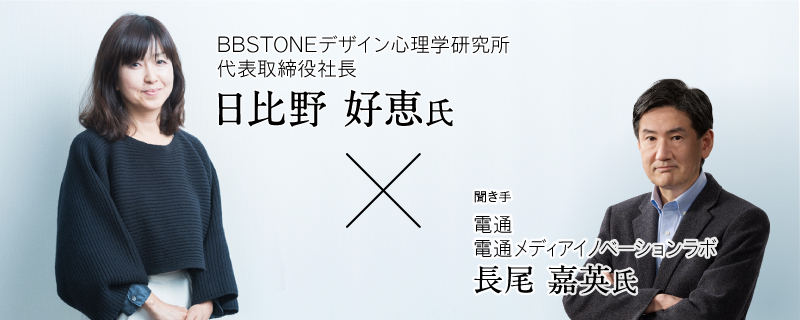Dentsu Inc. Media Innovation Lab has launched the "Audience Research Institute." Here, "audience" refers to the people who receive media information, consume content, and experience brand communication in today's rapidly evolving IT and media environment.
The organization aims to connect broadly with academics, research institutions, journalists, and others to disseminate information addressing various societal concerns related to audiences. It also seeks to provide insights and hints for business expansion and develop new marketing knowledge and methodologies through such activities.
This time, we welcomed Mr. Hibino, President of BBSTONE Design Psychology Research Institute, who specializes in design and development emphasizing how recipients perceive things psychologically, as our guest. We discussed the potential solutions inherent in design psychology.
Scientifically Exploring the Unspoken Truths of Human Emotions
Nagao: BBSTONE Design Psychology Research Institute, where Mr. Hibino serves as president, has been collaborating with us on joint projects for over ten years since we first worked together with Professor Haruo Hibino (Professor, Faculty of Engineering, Chiba University) on research regarding the perception of luxury in magazine advertisements. However, since around last year, it's been regrettable that we haven't been able to meet everyone in person due to the impact of the pandemic.
Hibino: It might be unavoidable for a while. I hear Chiba University students are also struggling, finding it hard to secure part-time jobs due to COVID. Adapting to the times is crucial going forward. We're developing new non-contact survey methods, and thankfully, we're receiving inquiries from various companies.
Nagao: Having collaborated for so long, I believe I understand your company quite well. But for readers encountering this article for the first time, could you introduce BBSTONE Design Psychology Laboratory? What kind of company is it? What are its goals? And what are its current priorities?
Hibino: We are a venture company born from Chiba University. Design psychology is a novel science that applies experimental psychology methods to uncover aspects of human behavior and speech that cannot be discerned through conventional means. By employing a psychological perspective, we can reveal consumers' true feelings, preferences, and decision-making processes – insights unattainable through traditional questionnaires or subjective evaluations.
Our core business theme is quantifying these inarticulate human truths (which we call visceral feelings). We provide consulting services to society using patented technologies we've developed.
We go beyond simply assessing design readability, clarity, and impression; we also solve diverse corporate challenges using our unique experimental methods. Thanks to this approach, over 90% of our clients are listed companies, spanning financial institutions, major manufacturers, government agencies, and more.
Developing "Productive Grid Lines" that Fit Human Sensibilities
Nagao: Could you share some specific examples right away?
Hibino: For example, one recent project involves developing "new grid lines" for which we have officially obtained intellectual property patents.
Humans tend to experience visual stress when exposed to geometric regularities like grid lines. Therefore, our company focused on the effects known as "optical illusions" and "subjective contour lines," applying these to develop original grid lines that assist work efficiency and study efficiency. The concept looks something like this.

[Image of patented grid lines]
Features distinctive breaks rather than simple straight lines
Our experimental results show that notebooks using these lines reduce visual stress and fatigue compared to other lines, promising improved work efficiency for users.
Nagao: Could we say these are grid lines that fit the senses humans inherently possess? It's a groundbreaking invention no one had ever thought of before.
As mentioned earlier, at Dentsu Inc. Media Innovation Lab, where I belong, we refer to the recipients of information and messages as the "audience." We launched a unit called the "Audience Research Organization" to advance audience-focused research while connecting more broadly with society.
In terms of recipients, your company emphasizes designs and developments that prioritize how recipients psychologically perceive them, right? For example, you have various successful cases like the "remote control tailored to the sensibilities of the senior demographic" developed with Daikin Industries, which also won the Good Design Award.
Hibino: Our company is deeply committed to exploring the profound aspects of human nature. We particularly aim to shine a spotlight on preferences that defy verbalization, the unseen psychology of people, and even subconscious feelings they themselves may not recognize. By objectively quantifying these, we solve problems that align with our clients' needs. Audience is also the core theme of the business we provide.
The Era of Focus on Customer Experience (CX)
Nagao: By the way, recent marketing has placed particular emphasis on customer experience (CX). It's not just about the experience at the point of purchase or service delivery; it's about maximizing value throughout the entire customer journey with the brand, encompassing the period before purchase and extending beyond it. This has become a key evaluation point in marketing.
Hibino: We believe creating experiences that excite and thrill customers throughout their consideration process for products or services is also a key point for our company.
As a recent example, we collaborated with a cosmetics manufacturer to develop a system that sheds light on customers' "deep-seated psychology." This system scientifically uncovers the correlation between specific facial concerns and underlying psychological factors. Using this method, customers can understand how their own unrecognized deep-seated psychology contributes to their "facial concerns."
Based on this correlation, we developed a psychological test. Customers take a simple test to understand potential future concerns about their facial appearance, and the system then recommends skincare brands that address those concerns.

Nagao: I see! That's a very unique and innovative approach. And the fact that it's backed by rigorous scientific analysis is a major point.
Hibino: For women, the concept of "facial concerns" might generally be perceived negatively. However, by incorporating an exciting exploration experience based on design psychology—an approach uniquely promoted by our company in Japan—we enable a more positive engagement with this theme. We are confident this also contributes to fostering clients' affinity and trust toward the brand.
Offering potential value testing experiences to insurance service prospects
Nagao: Regarding customer experience, what are your future plans?
Hibino: Well, our company aspires to organically integrate CX with DX to achieve this vision. The aforementioned "facial concern" test also incorporates a mechanism that guides customers from physical retail spaces to digital initiatives.
And while this is still in the conceptual stage—or perhaps just a fantasy? (laughs)—we're also exploring methods to uncover people's latent lifestyle preferences and values.
For example, when discussing insurance products with a customer, we'd use an image-presentation tool to test and uncover their "perspective on life." We'd then show them the results and propose insurance types aligned with their underlying values. We're developing this under the name "Lifestyle Diagnosis Test."

Nagao: That sounds like an exciting customer experience along the path to choosing insurance services. If we could also verify potential shifts in customer feelings post-contract through online tests, it might further deepen integration with DX.
Hibino: We envision the "Lifestyle Diagnosis Test" as a solution applying the IAT (Implicit Association Test), a representative technique used in design psychology. Our company also consults on spaces that facilitate smooth customer meetings and comfortable workspaces within corporate offices. Integrating these organically and holistically could potentially create even more futuristic customer experiences.
Contributing to corporate HR and recruitment through design psychology's IAT
Nagao: Could you tell us a bit more about the IAT you just mentioned?
Hibino: The IAT was developed at institutions like Harvard University and the University of Washington in the US. Unlike traditional questionnaire methods, it's a psychological test where it's difficult to intentionally "put on a facade." We are also developing a method (CPAT, Career Personality Aptitude Test) that applies the same IAT concept to enhance corporate HR and recruitment strategies. This is essentially a non-verbal, latent career aptitude test.
Traditional aptitude tests sometimes reveal a tendency for applicants to "unconsciously present themselves in a favorable light" based on hiring criteria. In contrast, CPAT's non-verbal approach prevents self-presentation, revealing the true self.
It's important to note that we envision this tool not primarily as a pass/fail criterion, but rather to prevent career mismatches and broaden career choice possibilities. Looking ahead, we envision scenarios like analyzing the core values of a company's top sales staff and then matching applicants who share those values.
Nagao: Truly, the hidden potential is limitless! I feel design psychology solutions will become increasingly important going forward. Thank you for sharing your valuable insights today despite your busy schedule.
We must never forget that the audience receiving media information and brand experiences consists of real human beings, each unique. Therefore, in communicating with them, it is crucial to carefully delve into and address the profound aspects of human nature. In this sense, I believe utilizing an approach based on design psychology—the science of human potential—will become a key to creating effective customer experiences.
If you are interested, please contact Nagao at Dentsu Inc. Media Innovation Lab ( mediainnovation@dentsu.co.jp )!











